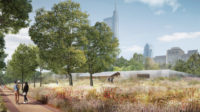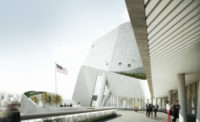Grimshaw Museum Expansion Taking Shape in NYC












The enlarged Queens Museum, which will open to the public in October, brings new technology and renewed purpose to a 100,000-square-foot building that has seen a hodgepodge of uses over the years. Back in 1939, as the New York City Pavilion, it stood alongside the famous Trylon and the Perisphere. When the fair closed, it alone remained in what is now Flushing Meadows-Corona Park. It briefly housed the United Nations General Assembly. And later, for the 1964 World’s Fair, it sported a new attraction: a huge scale model of the city.
Still a compelling sight, the Panorama of the City of New York was originally viewed from amusement park-like “helicopters.” They were replaced by cantilevered viewing platforms in a 1990s renovation by Rafael Viñoly. Since its founding in 1972, the museum, which now administers that panorama, has shared the remainder of the building with an ice rink.
In 2001, with plans to move the rink already in the works, the museum held a design competition, which was won by Los Angeles architect Eric Owen Moss. His plan called for an organic glass protrusion over the museum’s 1930s Deco-inspired colonnade. Tom Finkelpearl, who took over as museum director in 2002, worked with Moss on several redesigns before turning the project over to Grimshaw, a firm he believed could better interpret the museum’s needs, in 2005.
“The Board and I have the utmost respect for Eric’s talent as an architect; however, we decided to pursue a design that better suited the day to day purpose of the museum." Finkelpearl wrote in a e-mail, suggesting that the eccentricity of Moss’s design might have overshadowed some potential uses. During a press preview of the renovated building, he further explained the change in architects, saying, “We only get one chance.”
Making the most of that chance, Grimshaw, led by partner Mark Husser, who runs the firm’s 100-person New York office, has turned much of the building’s interior into a spectacular ensemble of galleries, lit from above by giant skylights with aluminum baffles. The smaller galleries at the edges of the former skating rink are sheltered beneath tapered aluminum airfoils, which will further diffuse natural light streaming into the building.
But the biggest change to the building may be that the main entrance has been moved to the building’s west façade. “For years,” said Finkelpearl, “you felt like you were coming in through the a side entrance.” From that threshold, covered by a huge stainless steel canopy, there will be views straight through the building to the Unisphere, a stainless-steel globe dating from the 1964 fair that is now a Queens icon and, somewhat unexpectedly, a frequent backdrop for hip-hop videos.
The front façade, with a lifeless procession of columns (part of the original 1930’s design by Aymar Embury II) has been enlivened with a combination of fritted glass and perforated aluminum panels. It will contain an LED lighting system announcing the museum to motorists on the Grand Central Parkway. “One thing is certain, you’ll know where the Queens Museum is,” said Finkelpearl. And thanks to the reinvention of the building by Grimshaw, along with an exhibition program designed to take advantage of the new spaces, there could plenty of reasons to visit.









